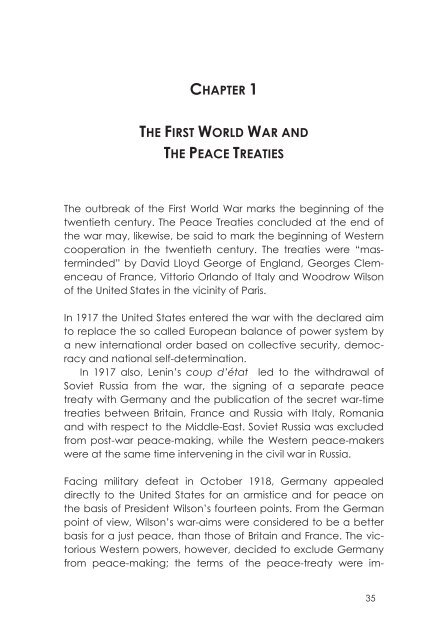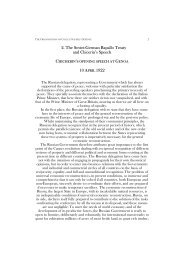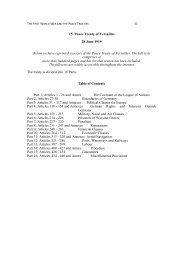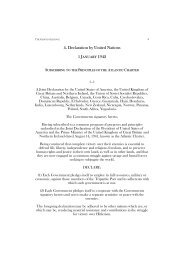CHAPTER 1 THE FIRST WORLD WAR AND THE PEACE TREATIES
CHAPTER 1 THE FIRST WORLD WAR AND THE PEACE TREATIES
CHAPTER 1 THE FIRST WORLD WAR AND THE PEACE TREATIES
You also want an ePaper? Increase the reach of your titles
YUMPU automatically turns print PDFs into web optimized ePapers that Google loves.
<strong>CHAPTER</strong> 1<br />
<strong>THE</strong> <strong>FIRST</strong> <strong>WORLD</strong> <strong>WAR</strong> <strong>AND</strong><br />
<strong>THE</strong> <strong>PEACE</strong> <strong>TREATIES</strong><br />
The outbreak of the First World War marks the beginning of the<br />
twentieth century. The Peace Treaties concluded at the end of<br />
the war may, likewise, be said to mark the beginning of Western<br />
cooperation in the twentieth century. The treaties were “masterminded”<br />
by David Lloyd George of England, Georges Clemenceau<br />
of France, Vittorio Orlando of Italy and Woodrow Wilson<br />
of the United States in the vicinity of Paris.<br />
In 1917 the United States entered the war with the declared aim<br />
to replace the so called European balance of power system by<br />
a new international order based on collective security, democracy<br />
and national self-determination.<br />
In 1917 also, Lenin’s coup d’état led to the withdrawal of<br />
Soviet Russia from the war, the signing of a separate peace<br />
treaty with Germany and the publication of the secret war-time<br />
treaties between Britain, France and Russia with Italy, Romania<br />
and with respect to the Middle-East. Soviet Russia was excluded<br />
from post-war peace-making, while the Western peace-makers<br />
were at the same time intervening in the civil war in Russia.<br />
Facing military defeat in October 1918, Germany appealed<br />
directly to the United States for an armistice and for peace on<br />
the basis of President Wilson’s fourteen points. From the German<br />
point of view, Wilson’s war-aims were considered to be a better<br />
basis for a just peace, than those of Britain and France. The victorious<br />
Western powers, however, decided to exclude Germany<br />
from peace-making; the terms of the peace-treaty were im-<br />
35
PART I: BETWEEN POWER POLITICS <strong>AND</strong> ALLIANCE OF DEMOCRACIES<br />
posed on Germany and the other central powers allied with<br />
Germany.<br />
The imposition of peace-terms on the central powers reflected<br />
the opinion after four years of cruel warfare, that they<br />
were being held responsible for the outbreak of the First World<br />
War. The “Commission on the Responsibility of the Authors of the<br />
War,” chaired by U.S. Secretary of State Robert Lansing, submitted<br />
the following conclusion to the Peace Conference of Versailles<br />
in 1919:<br />
36<br />
“The War was premeditated by the Central Powers together with<br />
their allies, Turkey and Bulgaria, and was the result of acts deliberately<br />
committed in order to make it unavoidable. Germany, on<br />
agreement with Austria-Hungary, deliberately worked to defeat<br />
all the many conciliatory proposals made by the Entente Powers.”<br />
This opinion – of German guilt in particular – is no longer supported<br />
by historical research into the causes of the outbreak of<br />
the war. In 1919, however, this opinion found much support in the<br />
fury of a war fought outside German territory, and in the atrocities<br />
committed by German forces in Belgium and by Turkey<br />
against the Armenians. As the fury of the war mounted, and<br />
leaders were prepared to risk the entire order of European life to<br />
win the war, hatred dictated the conduct of the war to the bitter<br />
end.<br />
<strong>THE</strong> FURY OF <strong>THE</strong> <strong>WAR</strong><br />
The First World War began a month after the assassination of the<br />
Austrian Archduke Ferdinand in Sarajevo, with the Austrian declaration<br />
of war on Serbia. Within days Germany and Russia were<br />
at war, Turkey became a German ally, and Germany declared<br />
war on France. Britain entered the war over the violation of Belgium’s<br />
neutrality by Germany. For Germany, neutrality was no<br />
more than “a scrap of paper” to be disregarded in what it<br />
deemed to be a struggle for its existence against two assailants
<strong>THE</strong> <strong>FIRST</strong> <strong>WORLD</strong> <strong>WAR</strong> <strong>AND</strong> <strong>THE</strong> <strong>PEACE</strong> <strong>TREATIES</strong><br />
(France and Russia). For Britain the defence of Belgian neutrality<br />
was a matter of “life or death” for the honour of Great Britain.<br />
The document regarding “The Violation of Belgian Neutrality”<br />
1 records the violation of Belgian neutrality and the atrocities<br />
committed by the invading German forces: the German military<br />
proclamations and the burning of Louvain. The terrorising of the<br />
civilian population was – and would become – an instrument of<br />
modern, total warfare. As recorded in our second document, 2<br />
the German Army, for the first time, used poison gas in its attempt<br />
to break through the British and Belgian lines at Ypres.<br />
Ypres, as a monument to senseless and cruel warfare, would also<br />
become the symbol for the allied and associated powers of their<br />
championing small nationalities and the sanctity of treaties<br />
against a ruthless, authoritarian and aggressive Germany. From<br />
the outset and increasingly so, the war extended from the battlefields<br />
to the minds of men, as is shown in the document on the<br />
propaganda war. 3 For the Germans “treacherous” Britain became<br />
the principal target of hatred. For the Allies the German<br />
rulers were the source of all evil.<br />
The year 1915 was marked by two other decisions on the part<br />
of the central powers that would have lasting consequences for<br />
the war and the history of the twentieth century.<br />
The first one was the decision taken by the young Turkish<br />
movement, which ruled Turkey since 1908, to deport and exterminate<br />
the Armenian population. In the first, premeditated and<br />
carefully organised mass killing of this century, 4 more than a million<br />
Armenians perished for no other reason than their religion<br />
and nationality. Ottoman rule outside the Turkish heartland was<br />
replaced by Western rule and lasting Western involvement in the<br />
turbulent Middle-East.<br />
1 Document I.1.1 in “Western Cooperation” on our website.<br />
2 Document I.1.2.<br />
3 Document I.1.3.<br />
4 It was not until 1949 that mass killing of members of a national, racial<br />
or religious group was defined as the punishable crime of genocide<br />
in the Convention on Prevention and Punishment of the Crime of<br />
Genocide.<br />
37
PART I: BETWEEN POWER POLITICS <strong>AND</strong> ALLIANCE OF DEMOCRACIES<br />
The second one was the decision of the German Admiralty in<br />
1915 to conduct unrestricted submarine warfare, initially against<br />
enemy merchant vessels and two years later against any vessel<br />
found in the zone declared to be a war-zone by Germany; this<br />
decision and the United States response are recorded in the<br />
document on the sinking of the Lusitania. 5 The German decision<br />
of 1 February 1917 to extend submarine warfare to any vessel<br />
and the Zimmerman Note 6 were both of decisive importance for<br />
bringing the United States into the war on the side of Britain and<br />
France. On 3 February diplomatic relations with Germany were<br />
severed. The Zimmerman note was intercepted and released to<br />
the public on 26 February 1917, at the time Congress was debating<br />
a measure to arm merchantmen. It helped crystallise American<br />
public opinion against Germany, the more so as Zimmerman<br />
sought to justify his action before the German Reichstag and<br />
German submarines had sunk three American merchant ships in<br />
March 1917. On 6 April 1917 the United States entered the war<br />
on the side of Britain and France.<br />
PRESIDENT WILSON’S PROGRAMME OF <strong>THE</strong> <strong>WORLD</strong>’S <strong>PEACE</strong><br />
In his Address of 22 January 1917 to the Senate, 7 President Wilson,<br />
still unaware of the Zimmerman note, offered his ideas about<br />
peace as leader of a neutral power. The principles for “a peace<br />
without victory” were “American principles;” he proposed for a<br />
“peace between equals” and not for a victor’s peace to be<br />
“imposed upon the vanquished.”<br />
In his War Message of 2 April 1917 to Congress, 8 the tone,<br />
obviously, was very different. German submarine warfare<br />
“against commerce is a warfare against mankind. It is a war<br />
against all nations.” According to President Wilson:<br />
5 Document I.1.4.<br />
6 Document I.1.5.<br />
7 Document I.1.6.<br />
8 Document I.1.7.<br />
38
<strong>THE</strong> <strong>FIRST</strong> <strong>WORLD</strong> <strong>WAR</strong> <strong>AND</strong> <strong>THE</strong> <strong>PEACE</strong> <strong>TREATIES</strong><br />
“A steadfast concert for peace can never be maintained except<br />
by a partnership of democratic nations. No autocratic government<br />
could be trusted to keep faith within it or observe its covenants.<br />
The world must be made safe for democracy.”<br />
As an ally to Britain and France, President Wilson did not give up<br />
his principles for a just peace, in “the fourteen points, the four<br />
principles and the five particulars.” 9 His programme elaborated<br />
on the principles enunciated in the Address of 22 January 1917.<br />
The main difference with the January Address was that he no<br />
longer advocated peace without victory. He accepted that the<br />
peace he sought was to be imposed upon the Central Powers.<br />
Germany still, but in vain, hoped for a peace with honour, but<br />
was excluded from the Peace Conference. When President<br />
Wilson arrived in Paris, he got a rousing reception and received<br />
broad and enthusiastic support in the West, not in the least from<br />
the delegates to the Peace Conference. As Harold Nicholson<br />
wrote:<br />
“Not only did I believe profoundly in these principles, I took it for<br />
granted that on them alone would the Treaties of Peace be<br />
based. Apart from their inherent moral compulsion, apart from<br />
the fact that they formed the sole agreed basis of our negotiation,<br />
I knew that the President possessed unlimited physical power<br />
to enforce his views. We were all, at that date, dependent on<br />
America, not only for the sinews of war, but also for the sinews of<br />
peace. Our food supplies, our finances, were entirely subservient<br />
to the dictates of Washington. The force of compulsion possessed<br />
by Woodrow Wilson in those early months of 1919 was overwhelming.<br />
It never occurred to us that, if need arose, he would<br />
hesitate to use it. ‘Never,’ writes Mr. Keynes, ‘had a philosopher<br />
held such weapons wherewith to bind the Princes of the world.’<br />
He did not use these weapons. He was not (and the slow realisation<br />
of this was painful to us) a philosopher. He was only a<br />
prophet.” 10<br />
9 Document I.1.10.<br />
10 Harold Nicholson, Peace-Making 1919, London 1964.<br />
39
PART I: BETWEEN POWER POLITICS <strong>AND</strong> ALLIANCE OF DEMOCRACIES<br />
According to Nicholson, this confidence was shared by his colleagues<br />
who were his equals in age or status, but as the weeks<br />
passed, “we suffered (…) a loss of confidence, a decline in idealism,<br />
a change of heart.” The Peace Treaty, as it finally<br />
emerged from the conference, was in contrast to most of the<br />
principles enunciated by the fourteen points.<br />
Events preceding the conclusion of the Peace Treaty<br />
To understand this outcome, we must briefly summarise some of<br />
the events preceding the conclusion of the Peace Treaty.<br />
Although Germany accepted some of the principles enunciated<br />
by President Wilson in the Reichstag Peace Resolution, 11 the<br />
resolution did not answer President Wilson’s suggestion to state<br />
clearly the aims for which Germany was fighting.<br />
America’s entry into the war left only the Holy See as an advocate<br />
for peace without victory. The Peace Proposal of Pope<br />
Benedict XV, 12 however, was generally disregarded by the warring<br />
parties.<br />
In February 1917 (8 March on our calendar) revolution broke<br />
out in Russia. Czar Nicholas II abdicated on 15 March after which<br />
the Bolshevik Party could function legally inside Russia. In April<br />
Lenin arrived in Petrograd, thanks to German permission to travel<br />
in a sealed train from Switzerland through Germany to Finland. In<br />
October (7 November on our calendar) Lenin took power<br />
through the putsch of the Bolsheviks. On 15 December he signed<br />
an armistice with Germany, followed by the Brest-Litovsk Peace<br />
Treaty of 3 March 1918 (abrogated in November 1918).<br />
By that time, Germany itself was in turmoil. Support for the war<br />
rapidly eroded. On 29 September – when Bulgaria surrendered<br />
and the Eastern Front collapsed – the German Supreme Commander<br />
urged the Kaiser to sue for peace. On 3 October Germany<br />
sent out her first peace note to President Wilson, the same<br />
11 Document I.1.8.<br />
12 Document I.1.9.<br />
40
<strong>THE</strong> <strong>FIRST</strong> <strong>WORLD</strong> <strong>WAR</strong> <strong>AND</strong> <strong>THE</strong> <strong>PEACE</strong> <strong>TREATIES</strong><br />
day a new German government was formed. Before the end of<br />
October Turkey signed an armistice. Early November developments<br />
rapidly drew to a conclusion. The German western front<br />
collapsed and the Allies stated their willingness to conditionally<br />
accept an armistice based on Wilson’s fourteen points. 13 The<br />
revolutionary movement spread through Germany. The Social<br />
Democrats proclaimed the republic on 9 November and the<br />
Kaiser asked and received political asylum in the Netherlands<br />
the day thereafter (his abdication from the throne followed on<br />
28 November). The Allied terms for an armistice were accepted<br />
by Germany the following day. 14 They set the stage and predetermined<br />
the outcome of the Peace Conference. The Allies –<br />
France and Britain in particular – were not willing to accept<br />
peace on the basis of Wilson’s programme. President Wilson<br />
wanted his League of Nations and was prepared to make concessions<br />
in the expectation that the League could redress the<br />
harsh terms of the peace treaty. Germany was too weak to obtain<br />
a more acceptable agreement. Within a month after submitting<br />
its counter-proposals to the draft-treaty, Germany unconditionally<br />
accepted the Treaty of Versailles. 15<br />
By the summer of 1918, the second major central power – the<br />
Austrian-Hungarian Monarchy – was rapidly dissolving. When the<br />
Armistice between the Allied powers and Austria-Hungary was<br />
concluded on 3 November 1918, the Czechoslovaks and the<br />
Yugoslavs had already declared their independence and the<br />
Austrian Republic had been proclaimed. The Hungarian Republic<br />
was proclaimed on 16 November, the United Kingdom of<br />
Serbs, Croats and Slovenes on 24 November. Austria and Hungary<br />
were in no position to resist the imposition of peace-terms<br />
by the Allied powers.<br />
13 Document I.1.11.<br />
14 Document I.1.12.<br />
15 Document I.1.14.<br />
41
PART I: BETWEEN POWER POLITICS <strong>AND</strong> ALLIANCE OF DEMOCRACIES<br />
<strong>THE</strong> <strong>PEACE</strong> <strong>TREATIES</strong> WITH GERMANY, HUNGARY <strong>AND</strong><br />
AUSTRIA<br />
In this paragraph we discuss excerpts from the Treaty of Versailles<br />
with Germany; the Treaty of Saint-Germain with Austria; the<br />
Treaty of Trianon with Hungary and the separate peace treaties<br />
concluded by the United States with Germany, Austria and Hungary.<br />
16<br />
Although signed at different dates, the treaties of the Allied<br />
powers with Germany, Austria and Hungary were concluded in<br />
the vicinity of Paris and were similar in structure. As is shown in the<br />
table of contents of the Versailles Treaty, Part I contained the<br />
Covenant of the League of Nations, Part XIII the Constitution of<br />
the International Labour Organisation. Parts II-XII were similar in<br />
the three treaties. Parts XIV-XVI only appeared in the Versailles<br />
Treaty.<br />
Germany was to cede territory to Belgium and Denmark, to<br />
return Alsace-Lorraine to France, and to cede territory to a recreated<br />
state of Poland. Austria was to cede territory to Italy and<br />
to accept the new states of Czechoslovakia and Yugoslavia<br />
within the borders defined at the Peace Conference. Hungary<br />
was to cede two-thirds of its pre-war territory to, respectively<br />
Czechoslovakia, Yugoslavia, Romania and (following a plebiscite<br />
in Burgenland) Austria. German territory was essentially left intact.<br />
The Austrian borders – except those with Italy – conformed<br />
to the territory inhabited by German-speaking subjects of the<br />
Austrian-Hungarian Monarchy. Hungary was by far the greatest<br />
victim of the territorial re-arrangements; it lost 71.5% of its pre-war<br />
territory and 63.6% of its pre-war population.<br />
Special regimes were imposed for the Saar, for a free city of<br />
Danzig and for Eastern-Prussia. The German territory west of the<br />
Rhine was to be demilitarised and to be occupied by Allied and<br />
Associated Troops for a period of 15 years (Parts III and XV).<br />
16 Document I.1.15 (Excerpts from the Treaty of Versailles including “The<br />
Covenant of the League of Nations”); document I.1.16 (Excerpts from<br />
the Treaties of St. Germain and Trianon); and document I.1.17 (separate<br />
peace-treaty of the United States with Germany).<br />
42
<strong>THE</strong> <strong>FIRST</strong> <strong>WORLD</strong> <strong>WAR</strong> <strong>AND</strong> <strong>THE</strong> <strong>PEACE</strong> <strong>TREATIES</strong><br />
The nationality of subjects in the ceded territories was to be<br />
determined by the Western principle of territorial jurisdiction<br />
rather than the German (later East and Central European) principle<br />
of cultural or ethnic origin. Minorities were to be given<br />
equal rights. In East and Central Europe many problems of nationality<br />
and minorities would never be solved satisfactorily.<br />
Each of the three states was bound to strictly respect the<br />
independence of the other and of the newly created states. In<br />
the case of Germany, Austria and Hungary it meant that a German-Austrian<br />
Anschluss and an Austrian-Hungarian re-union<br />
were forbidden. The independence of Estonia, Latvia and<br />
Lithuania was to be respected as permanent and inalienable.<br />
Germany (Austria and Hungary) had to renounce all rights<br />
and interests outside Europe in favour of the Allied powers (as<br />
the case may be under a special mandates regime to be set up<br />
by the League of Nations).<br />
Each of the three states had to accept substantial reductions<br />
in their land forces, navies, air forces and armaments, to be executed<br />
under the control of Inter-Allied Commissions.<br />
Parts VII and VIII in the peace treaties (Penalties and Reparations)<br />
were and would remain the principal source of resentment<br />
against the new order, especially in Germany. Each of the three<br />
states had to recognise the right of the Allied powers to bring<br />
before military tribunals persons accused of having committed<br />
acts in violation of the laws and customs of war. Each of them<br />
also had to accept the war-guilt clause (articles 231 and 161<br />
respectively). There were two differences, however. Only the<br />
German Kaiser (article 227) was to be arraigned for a supreme<br />
offence against international morality and the sanctity of treaties<br />
and only Germany was to pay substantial reparations. The arraignment<br />
of the Kaiser never materialised, as the Netherlands<br />
refused the request to extradite him to the Allied powers.<br />
Separate U.S. Peace Treaties<br />
Whereas the U.S. Senate refused to give its consent, the United<br />
States did not become party to the peace treaties with Ger-<br />
43
PART I: BETWEEN POWER POLITICS <strong>AND</strong> ALLIANCE OF DEMOCRACIES<br />
many, Austria and Hungary. The U.S. concluded separate and<br />
identical peace-treaties with them in August 1921. The principal<br />
reason for the Senate’s refusal was that it neither wanted the U.S.<br />
to become a member of the League of Nations, nor did it want<br />
to be obliged to guarantee the new order created by the<br />
peace-treaties. Nevertheless the U.S. treaties with the three<br />
powers accepted the territorial, political and other provisions of<br />
the earlier peace-treaties.<br />
<strong>THE</strong> <strong>PEACE</strong>-<strong>TREATIES</strong> WITH TURKEY<br />
The Treaty of Sèvres, concluded in 1920, was similar in structure to<br />
the other peace treaties. The territorial and political concessions<br />
to be made by Turkey were harsh. Apart from the cession of<br />
Mesopotamia, Syria, Palestine and the Arab peninsula – Armenia<br />
figured as a party (and independent state) to the treaty. Kurdistan<br />
was to be given autonomy and independence within a<br />
year; and sovereignty over Smyrna was to be shared by Greece<br />
and Turkey. Article 142 required Turkey to repair the wrongs inflicted<br />
on the Armenian population. Turkey, however, refused to<br />
ratify the treaty. From 1919 Mustafa Kemal (one of the Young<br />
Turks) organised resistance against foreign occupation and defeated<br />
the Greeks in the Greco-Turkish war of 1920-1922. Following<br />
this defeat, Smyrna was destroyed, and its Armenian and<br />
Greek populations were forced to leave. 17 It became Turkey’s<br />
Izmir in which the memory of its past had to be erased. Armenian<br />
and Kurd independence never materialised. The Eastern Armenians<br />
(Yerevan) accepted Bolshevik rule and West Armenia was<br />
re-occupied by Turkey; while most of the remnants of the Armenian<br />
population fled to Lebanon and Syria.<br />
A new peace-treaty was negotiated and signed on 24 July<br />
1923 in Lausanne. 18 The treaty ratified an earlier Greek-Turkish<br />
17 Giles Milton, Paradise Lost. Smyrna 1922. The Destruction of Islam’s<br />
City of Tolerance, Sceptre London 2008.<br />
18 Excerpts of the two treaties are reprinted in document I.1.18.<br />
44
<strong>THE</strong> <strong>FIRST</strong> <strong>WORLD</strong> <strong>WAR</strong> <strong>AND</strong> <strong>THE</strong> <strong>PEACE</strong> <strong>TREATIES</strong><br />
Convention concerning the compulsory exchange of Greek and<br />
Turkish populations (an early example of agreed ethnic cleansing).<br />
On 29 October 1923 Turkey was proclaimed a secular republic<br />
with Mustafa Kemal (now called) Atatürk as its president.<br />
Turkey committed itself to equal treatment of its minorities, but its<br />
territory would include Western-Armenia and Kurdistan, without<br />
any further mention of the rights of Armenians and Kurds. Despite<br />
the commitments made by Turkey and its acceptance as a<br />
“Western state” thereafter, the treatment of its minorities and its<br />
observance of human rights would remain problematic until this<br />
very day. The extermination of the Armenians was to be forgotten<br />
and to be erased from memory. Greek-Turkish hostility would<br />
last out the century despite the later adhesion of Greece and<br />
Turkey to the Council of Europe and NATO.<br />
MARRED BY CONTRADICTIONS<br />
The peace-treaties thus were bound to fail as the basis for a new<br />
European peace and security order. France was too demoralised<br />
by the war and too weak in comparison to Germany to<br />
uphold its territorial arrangements. Britain was not willing to provide<br />
France with the guarantees she desired. The collective security<br />
system set up by the League of Nations could not guarantee<br />
the maintenance of the new order or assure the peaceful<br />
revision of the territorial provisions, as the United States did not<br />
become a member of the League. Soviet-Russia in its drive for<br />
world revolution was bent on disturbing rather than managing<br />
the new security order. The constitution of Comintern in March<br />
1919 was one of the instruments to do so. 19<br />
Germany was left alone in its resentment and its efforts to<br />
revise the territorial provisions of the peace-treaties. Its principal<br />
drive towards revision of the territorial provisions was bound to be<br />
directed to the borders with the newly created states in East and<br />
Central Europe. In this drive, Germany was likely to find an ally in<br />
19 Document I.1.13.<br />
45
PART I: BETWEEN POWER POLITICS <strong>AND</strong> ALLIANCE OF DEMOCRACIES<br />
Soviet-Russia, which was similarly excluded and equally resentful<br />
of the territorial changes made by the war and the peace arrangements<br />
and the Treaty of Riga with Poland.<br />
In several respects, the peace-treaties suffered from serious<br />
contradictions. The promise of a new order, contained in Part I<br />
(the League of Nations) and Part XIII (the International Labour<br />
Organisation) were contradicted by the harsh territorial, political,<br />
disarmament, penalty and reparation provisions imposed upon<br />
the vanquished.<br />
President Wilson’s programme to make the world safe for<br />
democracy required a partnership of democratic nations, as no<br />
autocratic government could be trusted to keep its covenants.<br />
Such a programme could justify or at least necessitate an imposed<br />
peace. At the time of the peace-conference, however,<br />
the lines were no longer clearly drawn. In all three states – Germany,<br />
Austria and Hungary – the leaders who had been considered<br />
the source of all evil, had left the scene and new republics<br />
had been proclaimed. In Germany, the Weimar Constitution of<br />
31 July created a parliamentary republic. The harsh terms of the<br />
peace treaties thus contradicted the very programme of President<br />
Wilson, by giving the new republics no chance to join the<br />
partnership of democratic nations. The imposition of punishment<br />
on the successor states contradicted the wish and diminished<br />
the possibility for a transition from autocracy to democracy.<br />
Turkey, on the other hand, was given that chance – primarily<br />
for strategic reasons – by much more lenient and negotiated<br />
terms in the Treaty of Lausanne, although it could not be trusted<br />
to keep its covenants. Its acceptance in the partnership of democratic<br />
nations contradicted the character of its regime and its<br />
refusal to repair or even acknowledge the wrongs done to the<br />
Armenian population. The way in which the “new Turkey” decided<br />
henceforward to deal with its Armenian and Kurdish minorities<br />
foreshadowed a practice with which we would become<br />
all too familiar in the twentieth century: the practice of organised<br />
forgetting. The minorities were simply declared out of existence.<br />
In the new and modernised Turkey, everybody would<br />
now be a happy Turk and the Kurds became mountain Turks.<br />
46
<strong>THE</strong> <strong>FIRST</strong> <strong>WORLD</strong> <strong>WAR</strong> <strong>AND</strong> <strong>THE</strong> <strong>PEACE</strong> <strong>TREATIES</strong><br />
Whoever resisted in the name of minority rights could thus be<br />
treated as an outlaw or “terrorist.” 20 Throughout the century the<br />
Western powers were all too willing to condone and acquiesce<br />
in this Turkish practice of organised forgetting and continuing<br />
ethnic warfare.<br />
No war – and this applied to the First World War in particular –<br />
leaves any of the warring parties without “dirty hands.” The good<br />
cause for which the Allied and Associated Powers claimed to<br />
fight also contradicted their own methods of warfare. The imposition<br />
of penalties and reparations contradicted the requirements<br />
for a just and democratic peace. It imposed punishment<br />
and revenge, where magnanimity and reconciliation would<br />
have been necessary.<br />
The Peace Treaties thus were marred by many contradictions<br />
and not in the least by the final contradiction between the assumed<br />
need for a rapid settlement by a peace treaty and the<br />
time needed for giving reconciliation a chance.<br />
20 A good example of this approach in: Kamuran Gürün, The Armenian<br />
File. The Myth of Innocence Exposed, Túrkiye Bankasi 1985. See, however:<br />
Akçam, Taner, A Shameful Act: The Armenian Genocide and<br />
the Question of Turkish Responsibility, Metropolitan Books 2006.<br />
47







